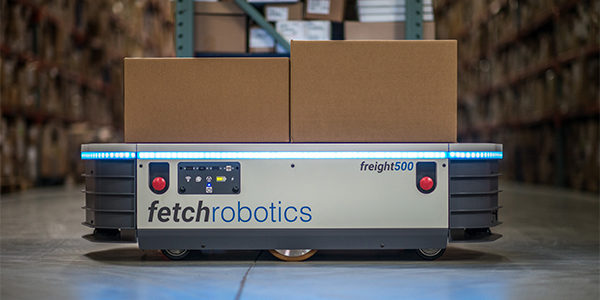Fetch Robotics adds larger warehouse models

Mobile robot vendor Fetch Robotics Inc. has added two new models to its fleet of autonomous material handling vehicles for commercial and industrial environments, adding to the fast-growing market of warehouse robotics.
San Jose, Calif.-based Fetch unveiled the Freight500 and Freight1500 models of its Autonomous Mobile Robot (AMR) design, designed to automate the delivery of bulky and heavy loads, the company said Thursday.
Named for their payloads in kilograms, the new models can carry 1,100 pounds and 3,300 pounds respectively, and join their smaller cousin, the original Freight, which can carry 220 pounds. All three models are just 14 inches tall, but their dimensions vary from about two feet by two feet for the original Freight to three feet by four feet for the Freight500 to four feet by four feet—full-pallet sized—for the Freight1500.
"The new models round out the capabilities for our customers, who have been working with a lot of different package size needs, from pieces to cases to pallets," Fetch Robotics CEO Melonee Wise said in an interview. "People wanted to move bigger loads, but the amount of room in packing and warehouse areas is not that large, so we did our best to give a medium-size robot a lot of muscle."
Seen in a video, the Fetch AMR lineup is similar in shape and function to self-driving material handling vehicles such as Amazon Robotics' Kiva robots and Clearpath Robotics Inc.'s Otto Motors designs, with a few clear distinctions.
In contrast to Kiva's strategy of moving entire racks of goods in a gated area of the warehouse, Fetch robots carry totes, bins, or pallets alongside human workers, moving at a top speed of about 4.5 miles per hour, Wise said. And althoughOtto robots have comparable capacities to the 100- and 1,500-kilogram versions, Fetch adds a mid-range 500-kilogram model. In addition, Fetch equips its robots to perform data collection as well as material transport by outfitting them with custom payloads such as cameras, radio frequency identification (RFID) sensors, or robotic arms as well as standard bulk loads, she said.
Managers can modify Fetch robots' routes to adjust to changing warehouse environments by using the company's cloud-based management software, Fetchcore. The application allows users to create and schedule workflows by adding stations, preferred routes, speed maps, and keep-out zones. The software also helps track battery life, which can range between 9 and 16 hours, depending on their use patterns during the work shift.
Related Articles

Copyright ©2024. All Rights ReservedDesign, CMS, Hosting & Web Development :: ePublishing